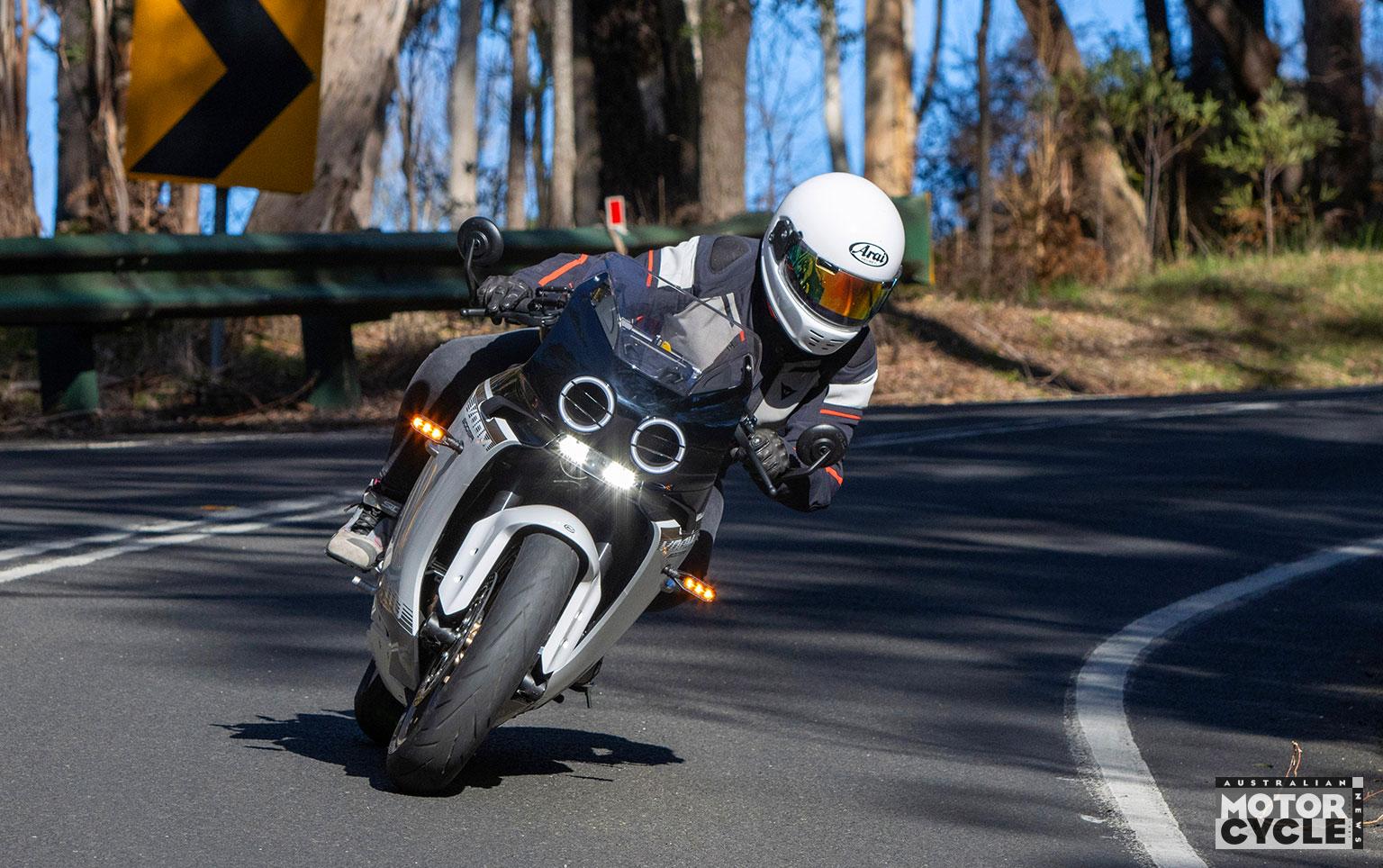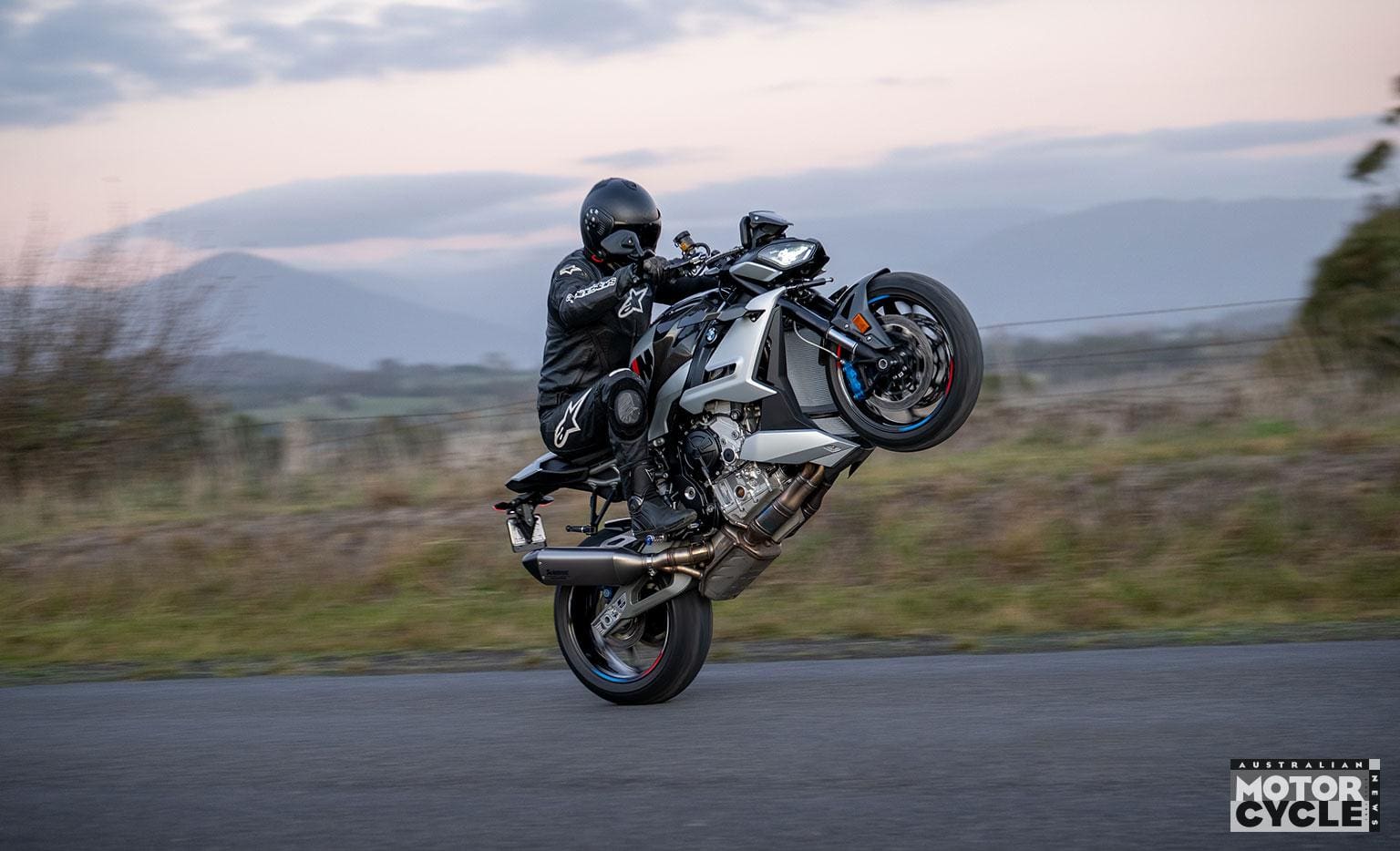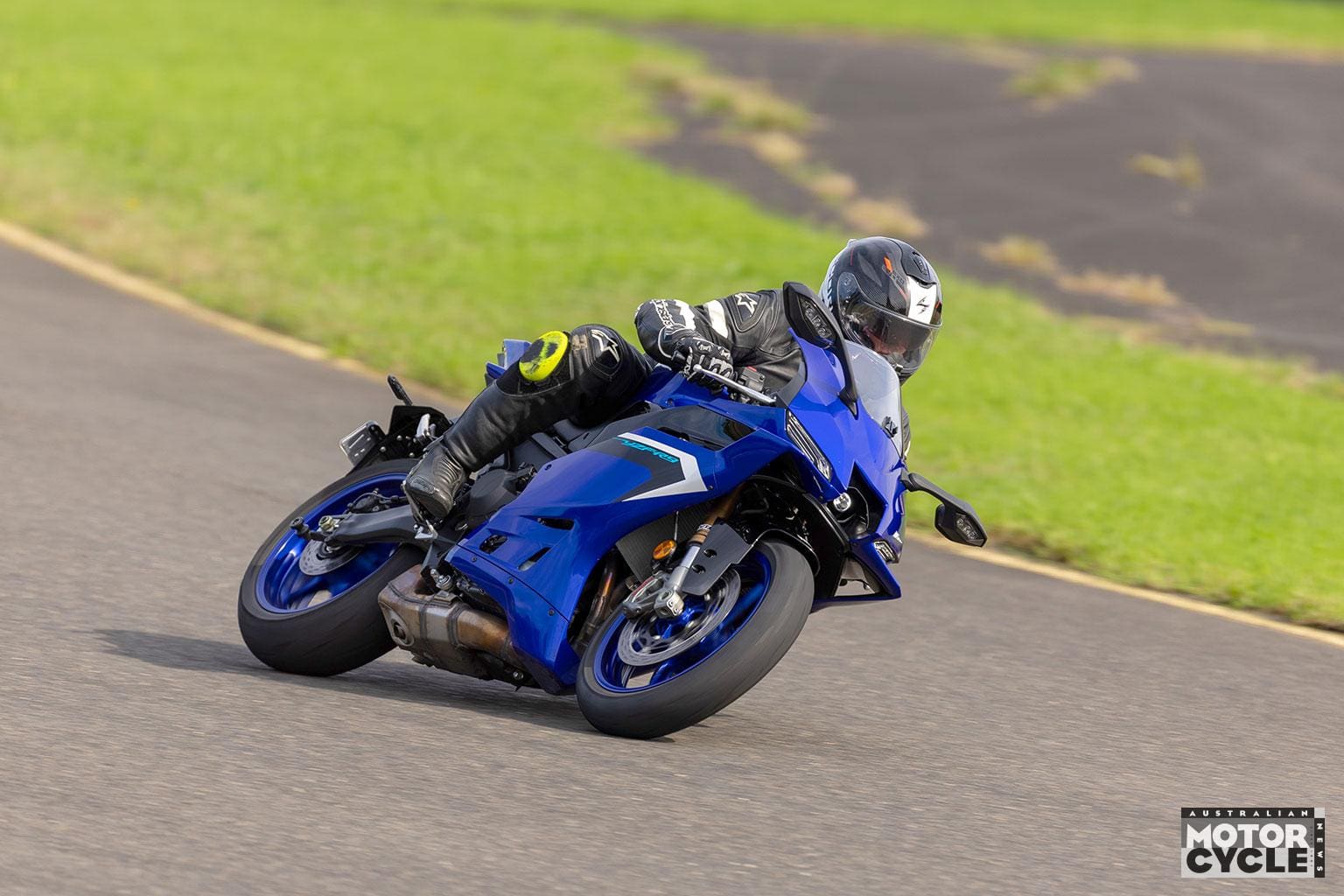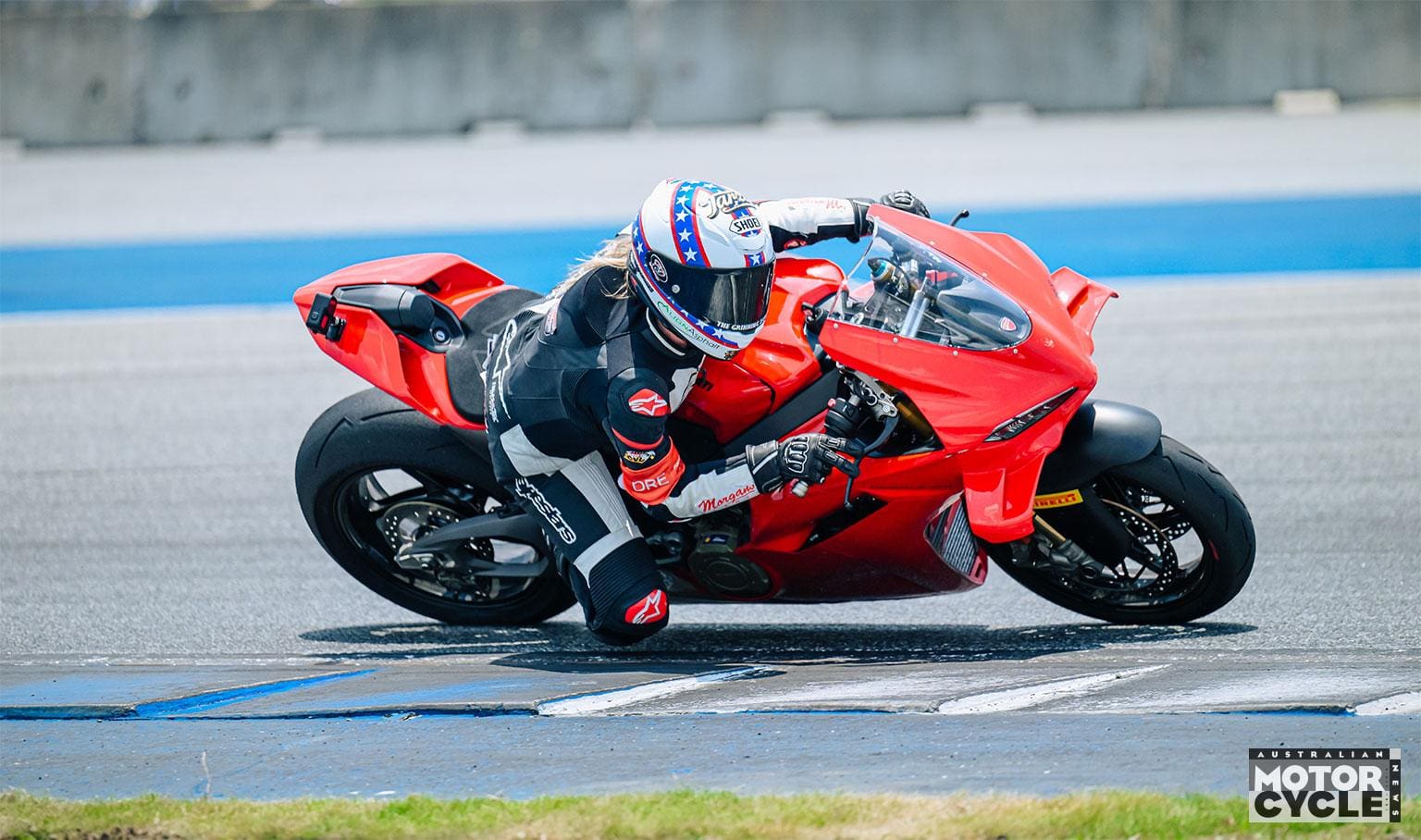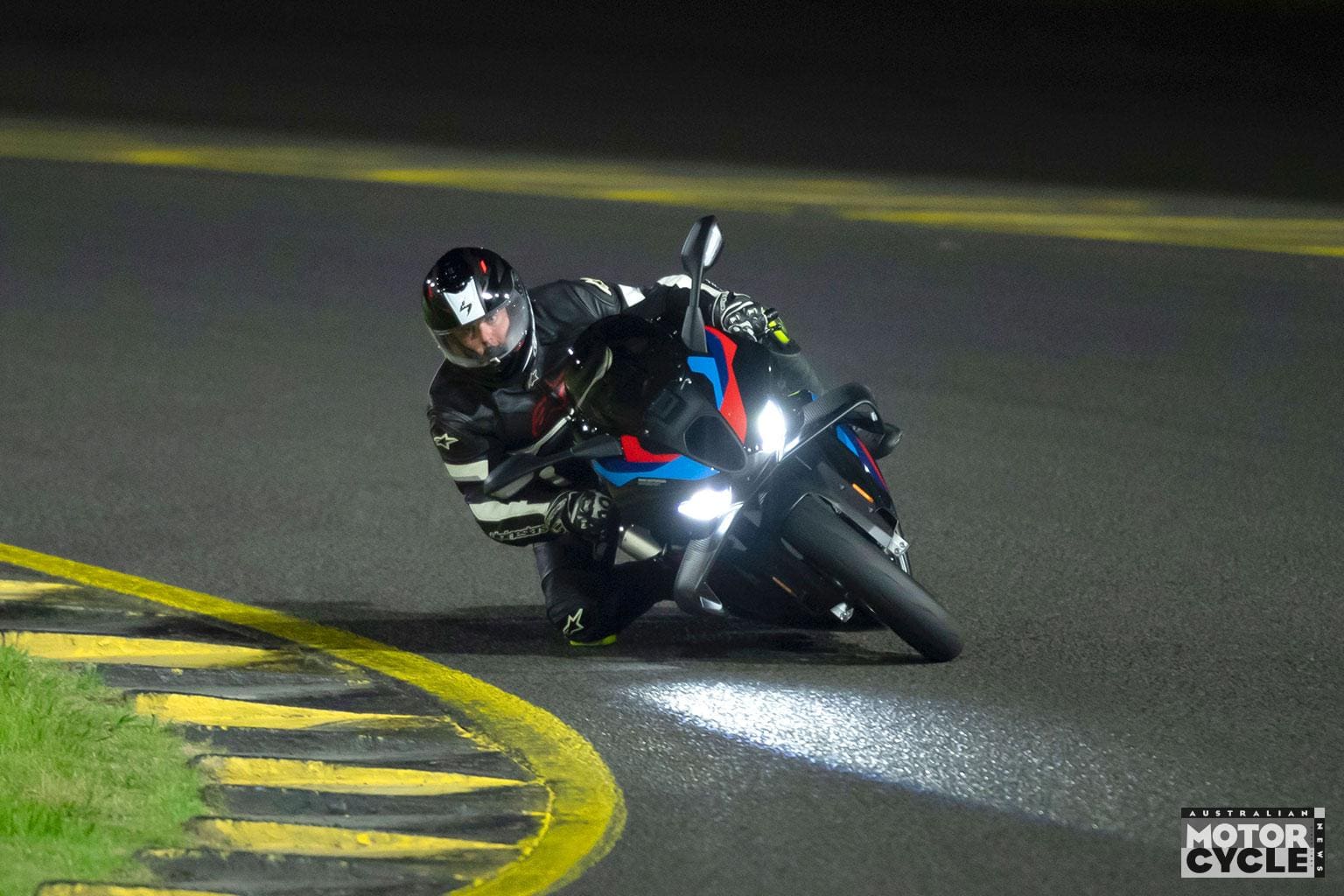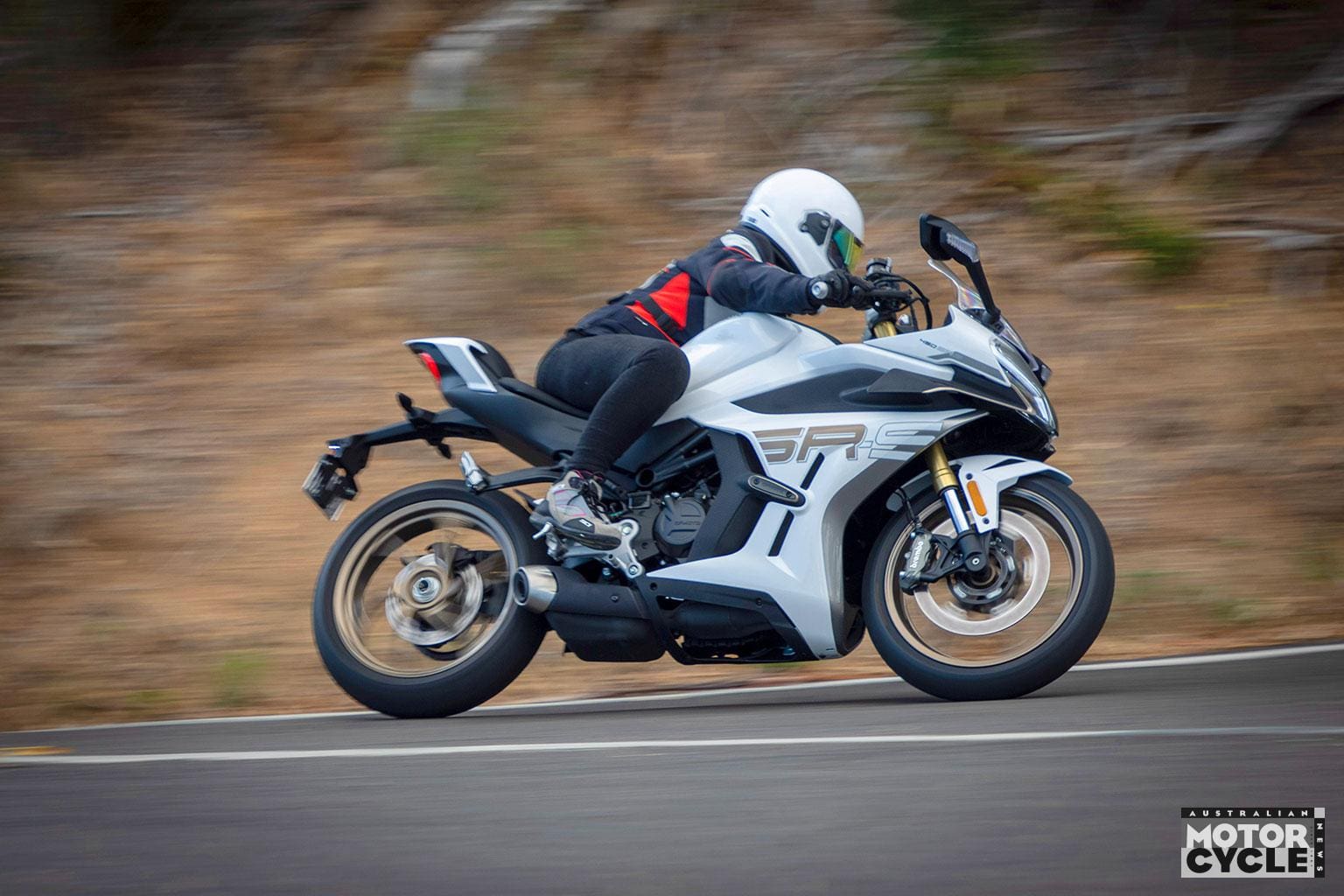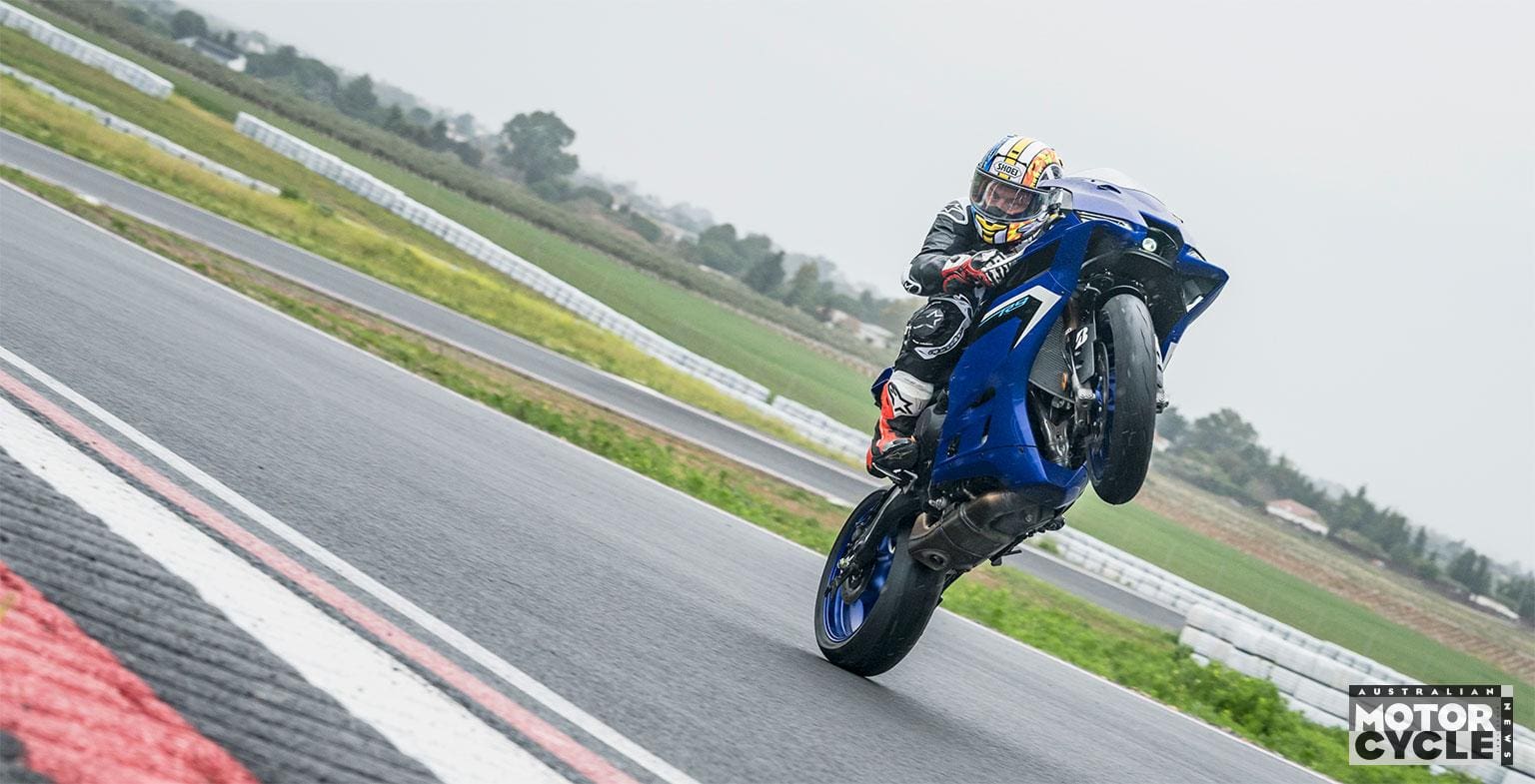With only 88 of these astonishing bikes being unleashed on the world, David Dumain had the huge privilege of testing the very first to roll out of production in France.
This isn’t the first time the Pôle Mécanique d’Alès-Cévennes, where MotoGP racer Johann Zarco often comes to ride, has hosted exceptional motorcycle tests. But it’s safe to say Box No 20 has probably never played host to so much concentrated value in its 45 square metres.
Four Aston Martins on their stands, including three AMB 001 Pros priced at €189,000 ($A300k) each, are arranged in a square. The Aston Martin Verdant Jade livery is magnificent, with fluorescent accents on the wheels, fairing and prominent wingtips, gracefully placed to increase aerodynamic pressure…
Speaking of pressure. It rises slowly at the thought of riding, for the first time, these marvels sporting the famous Aston Martin ‘Lacewing’ logo in aluminium designed for the Valkyrie program, which appears on the front wing and fuel tank, painted but covered with a thin layer of varnish for a perfectly smooth finish. This badge is 99.4 percent lighter than the brand’s traditional enamel badge, which, at just 70 microns thick, is 30 percent thinner than a human hair. A detail that illustrates the level of finish on such an expensive motorcycle. Above all, it reflects the trust placed by the prestigious British marque in the Toulouse-based structure in France to which Aston Martin delegates the manufacture of its official motorcycles. It is at Brough Superior, another prestigious British brand acquired in 2017 by Thierry Henriette from Toulouse, that these marvels are produced, each stage of the design process being validated by the brand’s management in Gaydon, Warwickshire.
Aston Martin Lagonda’s Design Director, Marek Reichman, was particularly attentive to the genesis of the project and the relevance of the collaboration with the French outfit that bought Brough Superior.
“There is no separation between the two,” he says. “There’s no separation between the advanced materials, the design and the technical capabilities of the bike. We’ve rediscovered this fluidity with Brough for those who want a super track bike like no other.
“The rider is part of this moving sculpture and will literally feel like part of the track when lying on the AMB 001 PRO.”
I don’t know whether the beads of sweat I feel running down my spine are due to the intense heat or the stress of being the first to set off on what looks like a racing prototype – except that production has been set at 88 units worldwide. This impression is confirmed when Simon, the engineer who assembles the engines and who himself carried out the first tests on the previous model, the AMB 001, starts the twin-cylinder engine with a hellish noise that shakes the body. My plan is to do a few laps with the grey AMB 001 before getting on the Pro version. And off we go.

I feel like I’m sitting on the bike, without really getting into the fairing like on some sports bikes. Leaning on the handlebar, there’s no alternative: it’s the power of the throttle. The turbo whistles and breathes loudly, the 180 horsepower (134kW) is there and the 380m straight seems far too short, even though fourth gear isn’t even fully engaged. I can’t imagine what the new AL 5000 engine will be like, with its machined aluminium crankcases and claimed 25 percent extra power…
I don’t think about it for too long and go back to my cornering lines, which I have to determine carefully, because the particular configuration of the chassis – with its carbon fibre bodywork and aluminium frame – is extremely rigid and requires great precision. All the more so as the Fior-type CNC machined aluminium fork, with its articulated double wishbone, is unable to correct the bike’s tight bends.
A finger on the brake lever and the Aston leaps off, fleeing towards the outside of the bend.
After a few laps, I feet I’ve seen enough with the AMB 001 to be able to set off on the Pro version.

First, a debriefing with Simon – who advises me to keep an eye on the engine temperature displayed on the touchscreen inserted in front of the central ridge running along the top of the faux tank, where the model number is engraved in the series. It is only then I realise I am on model 01/88! The very first one. I’m still savouring this moment when a deafening, hoarse noise tells me Simon has started the rocket. Now it’s up to me to get it into orbit.
So I set off on the first few laps cautiously, but without letting the Michelin tyres cool, because I’m well aware of the dangers of a low operating temperature. Then I let myself be bewitched by the noise of the monster, which sounds incredibly close to a MotoGP prototype. The delicate carbon fins also help transport me into the unique world of top-level competition.
A few words about aerodynamics, on which Aston Martin has been very meticulous. Downforce is increased by the front spoiler and side wings, with a cowling managing the downforce at the front of the bike. An air tunnel directs air over the rider. The air enters through a large intake integrated into the front wing, then passes through the new front cowling, before being deflected by the dynamic windscreen. To complete the picture, a rear spoiler acting as a stabiliser further refines the aerodynamic changes.
My lines – and my acceleration – are becoming sharper. The demanding character of the AMB Pro is similar to that of the AMB 001, and brings it closer to the quality of chassis I know from my riding experience on a Ducati Panigale. Obviously the fork doesn’t dive under braking, as the bike brakes flat, which takes a little getting used to. Front brake power is adequate, although you’d expect more aggression from the radial calipers that grip the twin 320mm discs. The rear brake offers enough bite to help position accurately for a corner. Once in the corner, the bike is glued to the ground, stalled and ready for a burst of throttle.

Cornering stability is one of the bike’s strong points. Coming out of bends, I appreciate the riding position, which allows me to dominate the machine, with excellent balance, thanks in particular to the petrol tank being positioned under the seat. The 1461mm wheelbase, longer than that of any production sportsbike, had made me fear that it would be difficult to handle. Not so, and the AMB 001 Pro moves from corner to corner with real ease. I even manage to rub the fairing lightly against the ground on one of the banked corners, proof that the Michelin Power Slicks allow a crazy angle, but also that the ground clearance needs to be reviewed.
The inverted gear selection, as on any self-respecting racing machine, also marks its racetrack intention, since the AMB 001 Pro is not homologated and isn’t road legal. The circuit’s main straight is definitely not long enough for me to feel the aerodynamic effects of this mechanical shark’s ‘whiskers’ (especially as on this occasion the turbo is hampered by a faulty sensor).
As I mentioned earlier, this new engine is estimated to have 25 percent more power than the AMB 001. My main complaint is that the turbo doesn’t work at full throttle to reach the power-to-weight ratio that the brand compares to that of a Formula 1 car: 1.28 bhp/kg.
Albert Castaigne, Managing Director of Brough Superior, explains this away by pointing out that it is the bike’s very first outing. So I immediately seize the opportunity to ask for another meeting, on the much longer Paul Ricard circuit perhaps?
But I don’t wait for a reply. Instead, I put the engine back in gear and set off for another exhilarating lap. I keep turning, throwing myself into the tight lefts and parabolic rights of the track, lulled by the clatter of the exhaust but ignoring it heating up my leather suit. Maybe too much… I don’t care, I’ll get to the end of the circuit, and even a little beyond… A dream comes to an end. Unattainable. Or almost.
To sum up my experience, which lasted a whole day and left my wrists a little strained, I’d say that the AMB 001 Pro intoxicated me to the point of forgetting its exorbitant price. The moderate power from the turbo due to a faulty sensor did nothing to spoil my experience of a new world: that of Aston Martin and its bewitching machines. Everything about this motorcycle exudes competition and meticulous attention to design detail, from the rigid chassis to the lively twin-cylinder engine and the highly engaging riding position. Each phase of riding must be broken down to get the most out of this sports bike. Its precision is matched only by its demanding nature, in the manner of a Ducati Panigale, considered a benchmark superbike.
Although many buyers of this sculptural model, perfectly suited to a showroom, will probably not take the risk of putting it on a racetrack, the fact remains that the Aston Martin AMB 001 Pro is a racing machine. A real one. And one that can achieve real lap times if you can get away from its stratospheric price tag.
Engine machined from solid block

The advanced technology required to manufacture Aston Martin engines has enabled the Brough Superior factory to take a new step forward in its development. Last year, the Toulouse plant acquired its new Haas 5-axis machining unit for its engine production line, which until now had been made from a traditional foundry block.
Developed for the production needs of the new Aston Martin AMB 001 Pro, the CNC-machined engine fits perfectly into the new Brough Superior Dagger or Lawrence models, but can also be used in the classic range, if the design of the CNC-machined block suits the buyer’s taste. The twin-cylinder engine is also lighter, stiffer and slightly more powerful, which may appeal to some customers concerned about the durability of their unique machine.
“The first deliveries took place in April and involved both new sales and bikes that were already in our order book,” explained Albert Castaigne, MD of Brough Superior Motorcycles. “We are offering this as an additional option.”
The architecture and displacement of the 997cc engine remain unchanged.
It should be noted that this 5-axis machining station is also used to shape the superb wheels that equip all Aston Martins, as well as a number of aluminium parts.

SPECS
ENGINE
Capacity 997 cc
Type 880 V-twin, DOHC, four-valves per cylinder, turbo-charged
Bore & stroke 94mm x 71.8 mm
Compression ratio not given
Cooling Liquid-cooled
Fuelling EFI
Transmission Six-speed
Clutch Wet, multiplate, APTC slipper clutch
Final drive Chain
PERFORMANCE
Power 165.6kW (225hp)
Torque 160Nm @ 6000rpm (claimed)
Top speed 290km/h (est)
Fuel consumption not measured
ELECTRONICS
Type Michelin Power Slick
Rider aids no
Modes no
CHASSIS
Frame material CNC aluminium
Frame type Structural engine and carbon fibre body
Rake 23.9°
Trail 102.6mm
Wheelbase not given
SUSPENSION
Front: Type Fior-type CNC Machined Aluminium fork with twin articulated triangular links and preload and rebound adjustable monoshock, 112 mm travel
Rear: Donerre monoshock preload and rebound adjustable, 124mm travel
WHEELS & BRAKES
Wheels Carbon fibre
Front: 3.5 x 17 Rear: 6.25 x 17
Tyres Michelin
Front: 120/70R17
Rear: 200/55R17
Brakes Beringer
Front: Dual 320mm discs, radial four-piston Monobloc calipers
Rear: Single 230mm disc, dual-piston caliper
DIMENSIONS
Weight 175 kg (dry, claimed)
Seat height 851 mm
Width 645 mm
Height not given
Length 2119 mm
Ground clearance not given
Fuel capacity 13 L
SERVICING & WARRANTY
Not a homologated vehicle, so only for private riding use
Maintenance after every riding day
BUSINESS END
Price €189,000 (ride away in Europe)
Colour options Aston Martin Verdant Jade, Aston Martin Racing Green
CONTACT
www.brough-superior-motorcycles.com/en/aston-martin-line
Ex-racer David Dumain is a leading French motojournalist and MotoGP commentator. This is his first ride with AMCN.



